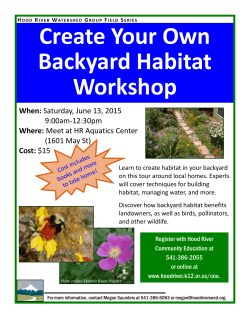
Document 211593
Teacher Guide ADAPTATIONS OF OHIO ANIMALS 50 Minute Science-‐To-‐Go lesson Grades: K -‐ 3 Description Discover the diversity of Ohio’s wetlands and forest animals. Using real furs, skulls, and other hands-‐on materials from Museum collections, students will explore various animal adaptations that specialize them for their specific habitat. Before Your Program/How To Set Up Your Room • • • • • Divide class into 3 groups Review the vocabulary with students Do the pre-‐activity with students Teacher must be present in classroom at all times Have 3 tables cleared for station work Objectives • • • • • Explore the basic needs of all living organisms Discuss the different ways that Ohio animals have adapted to specific habitats Identify some of the more common species of wildlife that may be observed in different habitats throughout the state. Explore the differences between aquatic and terrestrial mammals using skulls and furs Describe beak adaptations of different birds for specific food sources Revised Ohio Academic Content Standards Grade Kindergarten Science: Life Science – Physical and Behavioral Traits of Living Things • Living things have physical traits and behaviors, which influence their survival. Grade 1 Science: Life Science – Basic Needs of Living Things • Living things have basic needs, which are met by obtaining materials from the physical environment. • Living things survive only in environments that meet their needs Grade 3 Science: Life Science – Behavior, Growth and Changes • Individuals of the same kind differ in their traits and sometimes the differences give individuals an advantage in surviving and reproducing. Vocabulary habitat – the place where an organism lives adaptation – a body part, body covering, or behavior that helps an animal survive in its environment shelter – something that an animal uses for its home which protects it from the elements rostrum – the beak-‐like projection of an animal wetland – lowland area, such as a marsh or swamp, that is saturated with moisture food – material which provides animals with energy to survive forest – a habitat containing a large growth of trees, plants, and underbrush Suggested Activities Pre-‐Visit Activity 1. Schoolyard Habitat Exploration Take the students outside and have them explore their schoolyard habitat. Ask them to list the animals and plants they see. Do any of the animals have adaptations that help them live in their habitat? Post-‐Visit Activity 2. Schoolyard Habitat Book Report • Using the list of animals and plants from the pre-‐visit activity, have the students pick one of the animals or plants and have them give a short report on it. • The report should include the animal/plant name (common and scientific), a drawing of the animal/plant, its special adaptations, food preferences (animals), habitat, and other specific information of interest to the student. • Once the reports are completed, a classroom schoolyard habitat book can be put together and displayed. References Here are some sites that we have used in the past as resources for program content. Please note that the Museum is not affiliated with and does not endorse these websites. Biology for Kids http://www.kidsbiology.com/ National Wildlife Federation www.nwf.org Teacher Vision http://www.teachervision.fen.com/ Ohio Department of Natural Resources http://ohiodnr.com/Home/Education/default/tabid/9521/Default.aspx Science Resource Center (SRC) The Science Resource Center has books, slides, kits, animal dioramas and more for loan to area teachers. Contact the Science Resource Center at 216-‐231-‐4600 ext. 3211 between 3 and 5 PM Monday through Friday and 9 AM to 1 PM on Saturdays. _____________________________________________________________________________________ Produced and published by the Education Division, The Cleveland Museum of Natural History, 1 Wade Oval Dr., University Circle, Cleveland, OH 44106 September 2013
© Copyright 2025





















